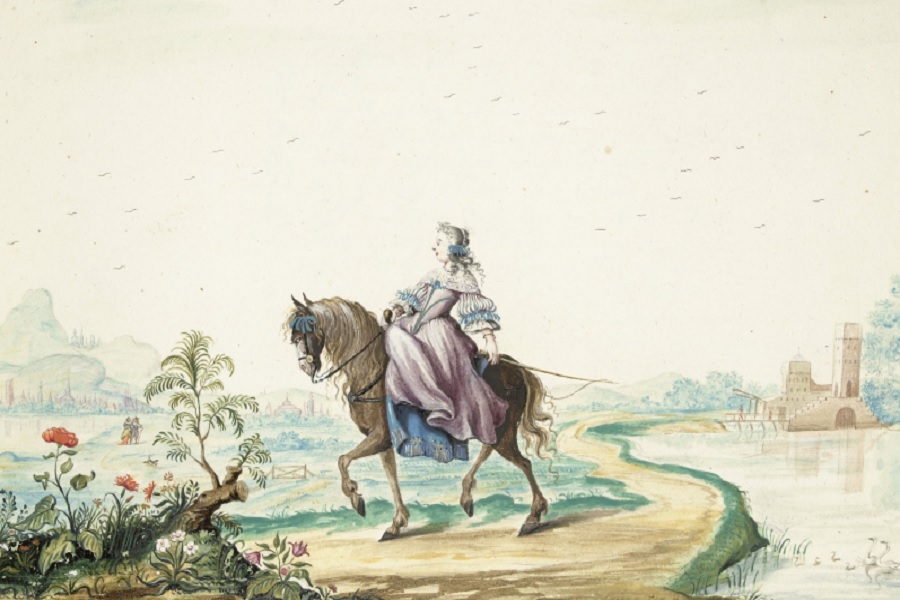Celia Fiennes and the Great North Road
Celia Fiennes was an early travel writer. She toured extensively through England in the late 17th century. Her diaries describe many of the towns, countryside and stately homes along the Great North Road.
The most relevant journeys were those made from London to Yorkshire in 1697, and south from Newcastle in 1698.
Celia Fiennes was born near Salisbury but went on to live with her sister in London. Her home was in Hackney, about 1 mile east of the Old North Road (the current A10).
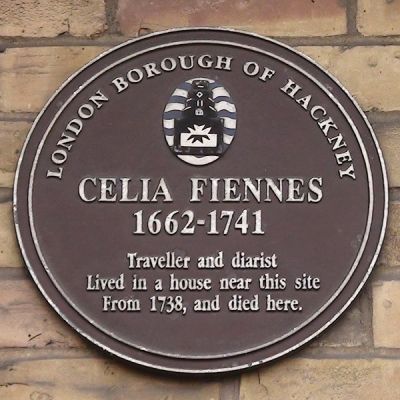
Plaque at Well Street, Hackney
About Celia Fiennes
Celia Fiennes was born in 1662 at Newton Toney near Salisbury, daughter of Nathaniel Fiennes, a politician and a Parliamentarian colonel in the civil war.

Celia’s father, Nathaniel Fiennes
Travel for its own sake was still a novelty. Celia’s journeys were made a little after those recorded by Samuel Pepys but well before those of Daniel Defoe. Roads left a lot to be desired, with the introduction of turnpikes not really getting going until the 1720s. Stage-coach services were starting to appear but for the curious traveller like Celia who wanted to explore, the answer was to travel on horseback. As was only decorous for a lady at that time, this meant travelling side-saddle.
It seems that she began her travels when she was in her early 20s “to regain my health by variety and change of aire and exercise“. But she got the bug and continued to make regular journeys in to her 40s. Sometimes she travelled with relatives, but often with just one or two servants. Her longest excursions were in 1697 when she travelled to Yorkshire, and in 1698 when in 6 weeks she included Newcastle, Scotland, and Land’s End!
For personal and family interest she edited her notes and diaries into a travel memoir in 1702. This work was published by a family member, Emily Griffiths, in 1888 as “Through England On a Side Saddle, in the time of William and Mary”.
Her writings describe a still largely unenclosed countryside with few and primitive roads. Signposts were only just appearing: “posts and hands pointing to each road with the names of the great towns or market towns that it leads to“.
Wealth and family connections meant Celia Fiennes was able to visit and appreciate some of the great country houses, but her attention was captured by many of the new and emerging features of the country. Growing towns and cities, the newly fashionable spa towns such as Bath and Harrogate, and emerging manufacturing industries and mining.
The impression gained from her memoir is of a strong-minded woman who did not hesitate to voice her opinions:
“if all persons, both Ladies, much more Gentlemen, would spend some of their tyme in Journeys to visit their native Land, and be curious to Inform themselves and make observations of the pleasant prospects, good buildings, different produces and manufactures of each place, with the variety of sports and recreations they are adapt to, would be a souveraign remedy to cure or preserve ffrom these Epidemick diseases of vapours, should I add Laziness? -it would also fform such an Idea of England, add much to its Glory and Esteem in our minds and cure the evil Itch of overvalueing fforeign parts”
Celia lived to be 78, dying at Hackney in 1741.
A Fine Family history
Celia was a member of that famous family line. She was grand daughter of William Fiennes in the graphic below.

Family History of Ranulph Fiennes, Explorer (Image Credit – Daily Mail)
Extracts from Celia Fiennes’ 1697 journey from London to York
Setting off in May, Celia initially heads towards Cambridge and Ely but joins our route at Huntingdon. She seemed to have privileged access to stately homes and recorded the grandeur and re-modelled gardens of the former Cromwell home, Hinchingbrooke House.
Huntington is but a Small Shire town; just by it is a house of the Lord Sandwich, yt it is pretty large. We enter a good Lofty hall, in it hangs the Ship in wch he was lost, that is the representation of it Cut out in Little and all things Exactly made to it; there is a good parlour and drawing roome: well proportion’d are ye rooms wth good old ffurniture and good Pictures. There is a Large dineing roome above wth good tapistry hangings, and its Ceil’d wth jrish oake Carv’d with points hanging down like fine ffret worke; this wood no spider will weave on or endure. There are good bed Chambers with good furniture and fine pictures; over one of the Chimneys is a fine picture of Venus were it not too much uncloth’d. The Gardens and Wilderness and Greenhouse will be very fine when quite ffinished with the dwarfe trees and gravell walks. There is a large fountaine or bason which is to resemble that in the privy garden at Whitehall, which will ffront the house. The high terrass walks Look out on the Road.
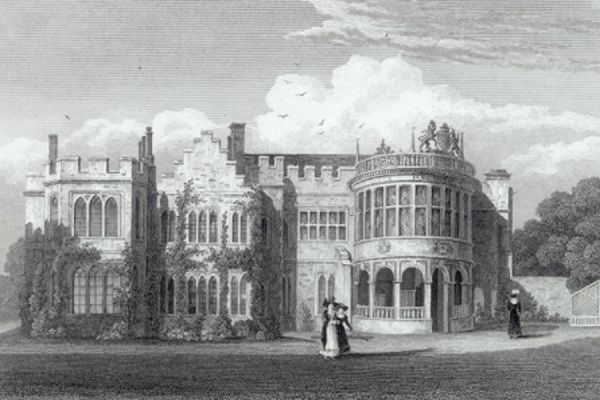
Hinchingbrook House by John Preston Neale, 1829
From Huntingdon, Celia travels towards Stilton and comments upon the great expanse of Whittlesey Mere. Then at Stamford she is effusive both about the town and nearby Burghley House.
Stamfford town is as fine a built town all of stone as may be seen; its on the side of a hill wch appears very fine in the approach.
Severall very good Churches with high Spires and towers very ornamentall’ its not very Large, but much ffiner than Cambridge, and in its view has severall good houses.
Lord of Exeters Burly house, Eminent for its Curiosity. The Situation is the finest I ever saw, on the Edge of the hill and severall Rows of trees of severall acres about it quite to the Road. It stands in a very fine parke wch is full of deer and fine Rows of trees. On Either side a very broad Glide or visto that Lookes finely to ye River and to the adjacent hills, a distance, both with fine woods. The town of Stamfford appears very fine on the Left hand and most noble woods on the Right hand. The house Looks very nobly; ye Garden very fine within one another wth Lower and higher walls deck’d with all Sorts of trees and Greens; very fine Gravell walks and Grass squaires wth Statues and fine Grass walks, dwarfs and all sorts of Green trees and Curious things: very fine fountaines, there is one in the middle of the Garden thats just to ye Middle also of the house, that is of an exceeding great size. There is a fine vineyard, Warren and Groves wch makes its prospects very delightfull.
Newark is a very neate Stone built town, the Market place is very Large and Look’d ffine; just by it is the Great Church wch is Large and with a very high Spire, there is prayers twice a day in it. There remaines the holes in the Church walls that the bullets made which were shott into the town in the Siege Laid to it by the Parliament army in the Civil warrs: the Castle was then demolish’d so yt only the ruinated walls remaine wch is washed by a very pretty river.
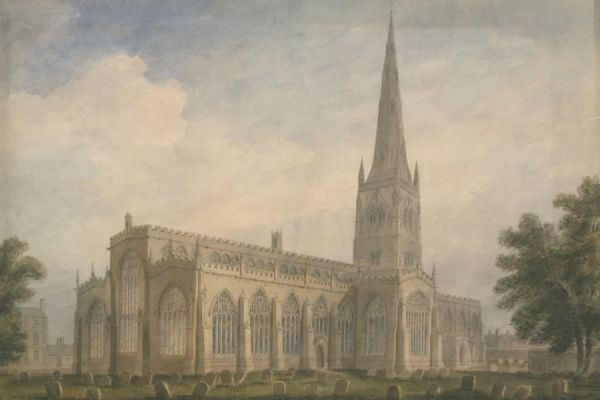
Newark Church, 1809, John Buckler
From Doncaster to Ferrybridge
This town stands on the River Don, wch gives name to the town, here is also a good Large Meeteing place. We were here the Lord’s day and well Entertained at the Angel. Thence we went to Wentbridge and pass’d by woods belonging to Sr Wentworth by his house 7 mile to Wentbridge, where had been a fire the night before Caused by the Lightening and thunder wch was remarkably great as we took notice of, 2 barnes and a house was burnt. Thence we ascended a very Steepe hill and so to Fferrybridge 3 mile where we pass’d the fine River Called the Aire, Large for Barges as was most of those Rivers I have mention’d.
With the exception of the cathedral, Celia Fiennes was not madly impressed by York.
The Streetes are Narrow and not of any Length, save one wch you Enter of from the bridge that is over the Ouise which Lookes like a fine River when full after much raine. It is but Low in Comparison of Some Rivers, it bears Great Barges, it Looks muddy, its full of good ffish. We Eate very good Cod fish and Salmon and that at a pretty Cheape rate, tho’ we were not in the best jnn for the Angel is the best in Cunny Streete. The houses are very Low and as jndifferent as in any Country town and the Narrowness of ye Streetes makes it appear very mean.
The Minster is very Large and fine of Stone, Carv’d all the outside, 3 high towers above the Leads; I was in one of them, the highest, and it was 262 steps and those very Steep Steps, there is a Gallery round the middle of the Church about halfe way that goes off these steps of the tower, where you may go round and Looke down into the body of ye Church and yt was so great a distance that the men and Ladyes that were Walking below look’d like Pigmyes a very little to us above. On the Leads of ye tower Shews a vast prospect of the Country, at Least 30 mile round, you see all over the town yt Lookes as a building too much Cluster’d together, ye Streetes being so narrow-some were pretty Long. There is another river wch fills the ditches round the town Called Ffosse. In the Minster there is the Greatest Curiosity for Windows I ever saw, they are so large and so Lofty, those in the Quire at ye End and on Each side that is 3 storys high and painted very Curious with History of ye Bible; the painting is very fine such as was in Kings Chapple in Cambridge, but the Loftyness of ye windows is more than I ever saw any Where Else and by all accounts is peculiar;
The Minster included a mint which she saw at work:
Here was a mint for Coyning the old money and plaite into new mill’d money; I saw them at work and Stamp’d one halfe Crown my Self-they dispatch worke very fast and have Coyn’d Severall 1000? . I see all parts of the work about ye pounding, the boyling, defineing and makeing Barres and Cutting out in ye mill and Bakeing and Stamping, all but Milling which art they are Sworne to keep private.
Celia takes a diversion to Harrogate where she seems keen to sample the less than appetising water.
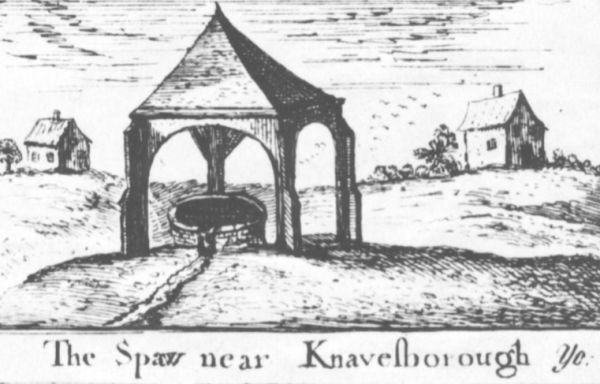
From thence we went over to Haragate wch is just by the Spaw, two mile further over a Common that belongs to Knarsborough; its all marshy and wett and here in the Compass of 2 miles is 4 very different springs of water; there is the Sulpher or Stincking spaw, not Improperly term’d for the Smell being so very strong and offensive that I could not force my horse Near the Well; there are two Wells together with basons in them that the Spring rises up in, which is ffurr’d with a White Scumm which rises out of the water, if you keep it in a Cup but a few hours it will have such a white Scumm on it, not withstanding it rises out of ye Spring very Cleare and so being a quick Spring itt Soone purges it Self Cleare againe, it Comes from Brimstone mines, for the taste and smell is much of Sulpher’ tho’ it has an additionall offenciveness Like Carrion. The Ground is Bitumus or the Like that it runns over, it has a quality of Changing Silver into ye Coullr of Copper and that in a few minutes, much quicker than the Baths in the West County in Somersetshire. Its a quick purger and very good for all Scurbutick humours, some persons drink a quart or two, I dranke a quart in a Morning for two dayes and hold them to be a good Sort of Purge if you Can hold yr breath so as to drinke them down.

The medicinal qualities of Harrogate’s spa waters were recognised in 1571 by William Slingsby, and in a treatise of 1598 eminent physician Dr Timothie Bright refers to “Harrogate spaw”. By 1700 Harrogate was well established as a spa, and promotional leaflets were being produced by the medical profession.
From Ripon she visits Sir Edward Blackett’s Newby estate. He had demolished the old house on the in 1695 and with the assistance of Sir Christopher Wren began building Newby Hall at a cost of £32,000. There is more information about Newby and an early illustration on the Daniel Defoe web page.
2 mile off is a fine place of Sr Edwd Blackets, it looks finely in ye approach in the Midst of a good parke, and a River runns just by it, it stands in the middle and has two Large Gardens on Each side. You Enter one through a Large Iron Barr-gate painted Green and gold tops and Carv’d in Severall places, this is ffine Gravel walks between grass plotts 4 Square, with 5 brass Statues Great and Small in Each square, and full of borders of flowers and Green banks with flower potts. On ye other side of ye house is just such a Garden, only the walkes are all grass rowl’d and the Squares are full of dwarfe trees, both ffruites and green, set Cross wayes wch Lookes very finely. There is a flower Garden behind ye house; in it and beyond it a Landry Close, with frames for drying of Cloths, walled in. There are good Stables and Coach house and all the offices are very Convenient-very good Cellars all arch’d, and there I dranke small beer four years old not too Stale, very Clear good Beer well brew’d. Their kitching, pastry and pantry & all very Convenient; in ye pantry hangs a picture of ye dimentions of a large ox yt was fed in these grounds wth ye acco of its weight. Ye Quarters was 106 Stone 1? and ye hide was 12 stone and 8 pound, the tallow was 19 stone, the head 4 stone, ye Legs and feate weigh’d 3 stone 11? . This Gentleman breeds and feeds much Cattle in his grounds and has one of ye largest Beeves in England.
his house is built with bricke and Coyn’d wth stone wth a flatt Roofe Leaded, wth railes and Barristers, and a large Cupilow in ye middle-you may see a Greate way round ye Country. Ye ffront Entrance is 3 gates of Iron Barres and spikes, painted blew with gold tops, and brick work between ye gates and pillars with stone tops Carv’d Like flower potts; ye pillars all Coyn’d with Stone. Ye Middle gate is made large in a Compass like a halfe Moone.
The hall you Enter is of a very good size and height. 2 dineing roomes and drawing roomes, one for the Summer with a marble floore, 6 or 7 Chambers off a good size and lofty, so ye most of ye beds were two foote too low wch was pitty they being good beds, one was Crimson ffigured velvet, 2 damaske beds, the rest moehaire and Cambet. Ye roomes were mostly wanscoated and painted. Ye best roome was painted just like marble-few roomes were hung. The ffurniture was very neately kept and so was the whole house, the roofe of ye Staires was finely painted, there was Severall pictures but not Set up the house being in mourning for his Lady, and her mother the Lady Yorke, wch dyed in a month or two of Each other. She left Sr Edward 10 Children, he has a great state and will have the 2000 P an fall to him that is Lady Mary Ffenwichs anuity. he was a merchants son at Bristol. The house is served with water by pipes into a Cistern into ye Garden, Cellars and all offices. This was the ffinest house I saw in Yorkshire.
Extracts from Celia Fiennes’ 1698 journey around England
After a foray into Suffolk, Celia Fiennes returned to Wansford in 1698.
I went thence to Wansford and passed by Mrs St Johns house wch stands on a hill a mile from ye town in a fine parke. There was no gate to Peterborough town and as I pass’d ye Road I saw upon ye walls of ye ordinary peoples houses and walls of their out houses, ye Cow dung plaister’d up to drie in Cakes wch they use for fireing, its a very offensive fewell, but ye Country people use Little Else in these parts. Wansford is 5 mile from Peterborough, where I passed over the Bridge wch Entred me into Northhamptonshire, the town being part in that shire wch is towards London, ye other in Lincolnshire wch a mile or two farther joyns wth Rutlandshire at Stamford, wch town stands in ye 3 Countyes, where I Lay at ” ye Swan in Wansford in England,” being a jest on a man makeing hay fell a sleep on a heap of it, and a great storme washed ye Hay and man into ye River and Carry’d him to ye Bridge, where he awoke and knew not where he was, Called to ye people in ye grounds and told them he liv’d in a place Called Wansford in England wch goes for a jest on ye men of Wansford to this Day.
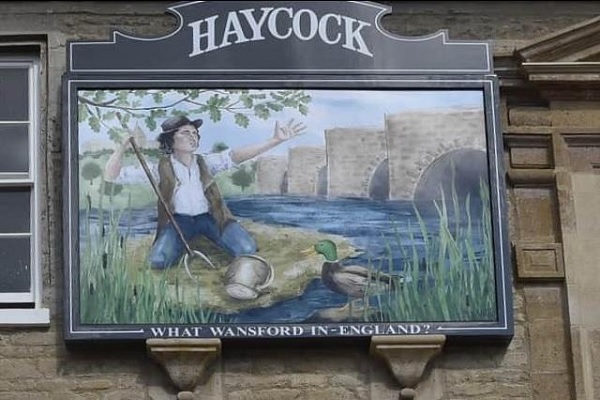
The Haycock Inn was formerly The Swan. the legend lives on.
Celia travelled north, exploring much of the North West. She briefly reached the lowlands of Scotland but was unimpressed by the accommodation options and was generally negative about the locals.
Those houses are all Kind of Castles and they Live great tho’ in so nasty a way as all things are in even those houses one has Little Stomach to Eate or use anything, as I have been told by some that has travell’d there, and I am sure I mett with a sample of it enough to discourage my progress farther in Scotland. I attribute it wholly to their sloth for I see they sitt and do Little.
She speaks positively about the River Tyne as she nears Newcastle but is less complimentary about the coal mining industry. Amongst the sites taken in was a visit to the Surgeons Hall where she witnessed dissected bodies.
Thence I went 4 mile along by the Tyne, the road was good hard gravelly way for the most part, but very steep up hills and down; on one of these I Rode a pretty while wth a great precipice on the Right hand down to the river, it Looked hazardous, but the way was very broad. The River Looked very reffreshing and ye Cattle Coming to its sides and into it where shallow to Coole themselves in the heate, for hitherto as I met wth noe Raines, notwithstanding the great raines yt fell the 2 dayes before I Left Woolsley, and ye Little showers I had when I went to Hollywell I was not annoy,d wth wet nor Extream heat, the Clouds being a shade to me by day and Gods good providence and protection all wayes. This after noon was the hottest day I met with but it was seasonable being in July. As I drew nearer and nearer to NewCastle I met with and saw abundance of Little Carriages wth a yoke of oxen and a pair of horses together, wch is to Convey the Coales from ye pitts to ye Barges on the river. There is Little sort of Dung-potts. I suppose they hold not above 2 or three Chaudron. This is the sea Coale which is pretty much small Coale tho’ some is round Coales, yet none like the Cleft coales and this is what ye smiths use and it Cakes in ye ffire and makes a great heate, but it burns not up Light unless you put most round Coales wch will burn Light, but then its soon gone and that part of ye Coale never Cakes, there fore ye small sort is as good as any-if its black and shineing, that shows its goodness. This Country all about is full of this Coale, ye sulpher of it taints ye aire and it smells strongly to strangers,-upon a high hill 2 mile from NewCastle I could see all about the Country wch was full of Coale pitts.
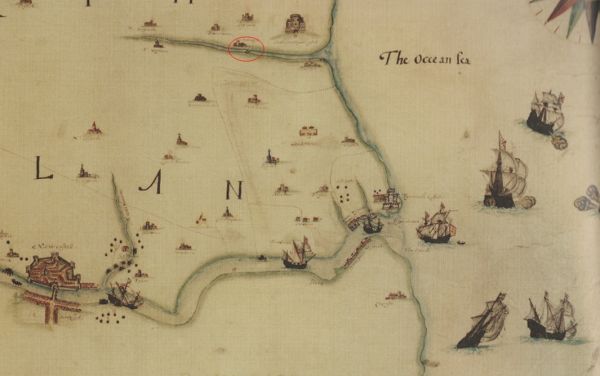
Celia Fiennes approaches Newcastle from the north: the approximate location of Hollywell is ringed in red on the 1590s map above; coal pits, staithes and trackways are just visible.
The North East had been shipping coal (especially to London) for 300 years, an estimated 650,000 tonnes per annum by 1700. Tramways were starting to be used and within 20 years new technology such as the Newcomen steam-engine would revolutionise the industry. Celia Fiennes accurately describes the “wainways” along which four-wheeled carts were pulled from the pits to the riverside staithes. From there, “keels” carried the coal to larger vessels anchored by the mouth of the river. At the turn of the 18th century there were about 1,600 keelmen employed, about 400 being seasonal Scottish workers.
New-Castle Lies in a bottom very Low, it appears from this hill a greate fflatt. I saw all by the river Tyne wch runns along to Tinmouth 5 or 6 miles off, wch Could see very plaine and ye Scheld wch is the key or ffort at the mouth of ye river wch disembogues itself into ye sea; all this was in view on this high hill wch I descended-5 mile more, in all nine from that place.
NewCastle is a town and County of itself standing part in Northumberland part in ye Bishoprick of Durham, the river Tyne being ye division. Its a noble town tho’ in a bottom, it most resembles London of any place in England, its buildings Lofty and Large, of brick mostly or stone. The streetes are very broad and handsome and very well pitch’d, and many of them wth very ffine Cunduits of water in Each allwayes running into a Large stone Cistern for Every bodyes use. There is one great streete where in ye Market Crosse, there was one great Cunduit with two spouts wch falls into a Large ffountaine paved wth stone which held at Least 2 or 3 hodsheads for the jnhabitants. There are 4 gates wch are all Double gates with a sort of Bridge between Each. The west gate wch I entred I came by a Large building of bricke within bricke walls, which is the hall for the assizes and sessions for the shire of Northumberland. This is NewCastle on ye Tyne and is a town and County. There is a noble Building in the middle of the town all of stone for an Exchange on stone pillars severall rows. On the top is a building of a very Large hall for the judges to keep the assizes for the town; there is another roome for ye Major and Councill and another for the jury out of the Large roome wch is the hall, and opens into a Balcony wch Looks. out on ye River and ye Key. Its a Lofty good building of stone, very uniforme on all sides wth stone pillars in the ffronts both to the streete and market place and to the waterside. There is a ffine Clock on the top just as ye Royal Exchange has. The Key is a very ffine place and Lookes itself Like an Exchange being very broad and soe full of merchants walking to and againe, and it runs off a great Length wth a great many steps down to ye water for the Conveniency of Landing or boateing their goods, and is full of Cellars or ware houses. Ye harbour is full of shipps but none that is above 2 or 300 tun Can Come up quite to the Key: its a town of greate trade. There is one Large Church built of stone wth a very high tower finely Carv’d full of spires and severall devises in the Carving-all stone. The Quire is neate as is the whole Church and Curious Carving in wood on each side the quire, and over the ffront is a great Piramidy of wood ffinely Carv’d full of spires. There was a Castle in this town but now there is noe remaines of it but some of ye walls wch are built up in houses and soe only appears as a great hill or ascent, wch in some places is 30 or 40 steps advance to the streetes that are built on ye higher ground where the Castle was. There was one place soe Like Snow Hill in London wth a fine Conduite. Their shops are good and are of Distinct trades, not selling m any things in one shop as is ye Custom in most Country towns and Cittys; here is one market for Corne, another for H ay, besides all other things wch takes up two or three streetes. Satturday was their biggest Market day wch was the Day I was there, and by Reason of the extreame heate resolved to stay till the sun was Low ere I proceeded farther, so had the opportunity of seeing most of the Market wch is Like a ffaire for all sorts of provision, and good and very Cheape. I saw one buy a quarter of Lamb ffor 3d and 2d a piece: good Large poultry. Here is Leather, Woollen and Linnen and all sorts of stands for baubles. They have a very jndifferent sort of Cheese-Little things, Looks black on the outside. There is a very pleasant bowling-green, a Little walke out of the town wth a Large gravel walke round it wth two Rows of trees on Each side Makeing it very shady: there is a fine entertaineing house yt makes up the ffourth side, before wch is a paved walke and Epyasses of bricke. There is a pretty Garden, by ye side a shady walk, its a sort of spring garden where the Gentlemen and Ladyes walke in the Evening-there is a green house in the garden, its a pleasant walke to the town by ye walls. There is one broad walke by the side of ye town runns a good Length made wth Coale ashes and so well trodden, and the raines makes it firm. There is a walke all round the walls of the town. There is a good ffree school and 5 Churches. I went to see the Barber Surgeons Hall wch was within a pretty garden walled in, full of flowers and greens In potts and in the Borders; its a good neate building of Brick. There I saw the roome wth a round table in it railed round wth seates or Benches for ye Conveniency in their disecting and anatomiseing a body, and reading Lectures on all parts. There was two bodyes that had been anatomised, one the bones were fastned wth wires the other had had the flesh boyled off and so some of ye Ligeament remained and dryed wth it, and so the parts were held together by its own Muscles and sinews that were dryed wth it. Over this was another roome in wch was the skin of a man that was taken off after he was dead, and dressed, and so was stuff’d-the body and Limbs. It Look’d and felt Like a sort of parchment. In this roome I Could take a view of the whole town, it standing on high ground and a pretty Lofty building.
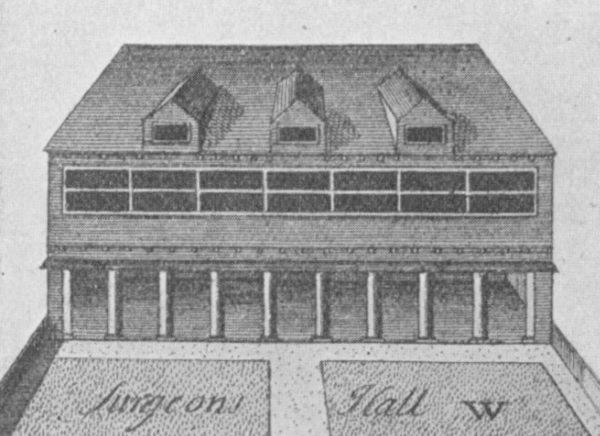
The Company of Barber Surgeons and Tallow Chandlers dates to the 15th century, and in 1648 the Surgeons successfully petitioned the town corporation for a grant of land to build a meeting house with a garden for medicinal herbs. They began to study anatomy and undertake dissections in the 1690s. Their first hall is depicted (above) in the margin of the 1723 Corbridge map of Newcastle. The hall was rebuilt in 1730 then again in the 1850s when the site was required for the railway north from the station.
Celia Fiennes travelled on to Durham via Chester-le-Street.
Durham Citty stands on a great hill, the middle part much higher than the rest, the Cathedrall and Castle wch is ye pallace wth ye Colledge and all the houses of the Doctors of the Churches is altogether built of stone and all Encompass’d wth a wall full of battlements above the walke, and this is about the middle of ye hill wch is a Round hill, and a steep descent into the rest of the town, where is the market place wch is a spacious place, and a very ffaire town hall on stone Pillars and a very Large Cunduite. From this all the streets are in a pretty greate descent to ye river, which Lookes very pleasant by meanes of its turning and winding to and agen, and so there are 3 Large Stone Bridges wth severall arches apiece. The abbey or yc Cathedrall is very Large, the quire is good but nothing Extraordinary, some good painting in the Glass of the windows and wood Carving. There is over ye alter a painting of a Large Catherine Wheele which Encompasses the whole window and fills it up.
The Castle wch is the Bishops pallace stands on a Round hill wch has severall green walks round it, wth high bancks to secure them one above another, and on the top are the towers. About the Middle of the hill is a broad Grass walk railed in and enters into a Dineing roome. There are very stately good roomes, parlours, drawing roomes, and a noble Hall, but the ffurniture was not very ffine the best being taken down in the absence of my Lord Crew, who is not a Barron of England but is a great prince as being Bishop of the whole principallity off Durham, and has a great Royalty and authority, is as an absolute Prince and has a great Command as well as revenue; his Spirituall is 5 or 6000lb and his temporalls since his brothers Death makes it much more. He Comes sometymes hither but for the most part Lives at another Castle wch is a noble seate about 12 mile off, which is very well ffurnish’d and ffinish’d; he is the Governour as it were of the whole province.
Darlington gets a mention for its cattle market – then Hell’s kettles, near Croft which was the site of many travellers’ tales through the coaching era.
This is a Little Market town, the Market day was on Munday wch was the day I passed through it: it was a great Market of all things, a great quantety of Cattle of all sorts but mostly Beeves- it seemes once in a fortnight its much fuller. Two miles from Darlington I Came to the Ground the Hell Kettles are they talk much of, its in Grounds just by the road where Cattle were ffeeding, there are 2 pooles or ponds of Water the one Larger than ye other; ye biggest seemed to me not to be the Deepest nor is it Esteem’d soe deep; there was some sedge or flaggs growing round that, but ye fathermost wch was not soe bigg Looked a Cross that had noe flaggs or sedge on its bancks but yet it Look’d to me to Cast a green hew, Roleing waves of the water just in Coullour as the sea, and as the wind moved the water it very much resembled the sea, but the water when taken up in ye hand Look’d White and ye taste was not the Least brackish but fresh. My Conception of the Cause of ye greenish Coullour was from the greate depth of water, for the reason they Call them Hell Kettles is that there is noe sounding a bottom, wch has been try’d by plumet and Line severall ffathoms down; the water is Cold and as any other water when took up, it seemes not to Decrease in a tyme of Drought nor to advance wth great raines, it draines itself insensibly into ye ground.
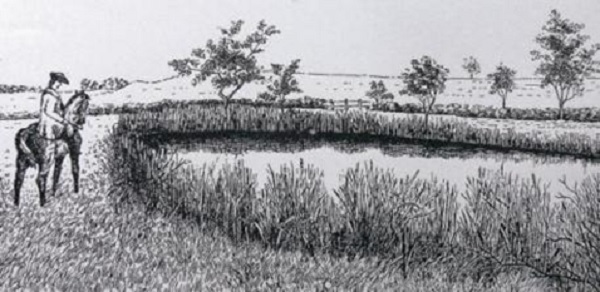
As hinted at by Fiennes, the larger pool one is filled by surface water run-off whilst the other is fed from deep underground springs. They have featured in local folklore for many centuries: Tudor chronicler William Harrison said locals refer to them as “the Kettles of Hell, or ye Devil’s Kettles, as if he should see the soules of sinfull men and women in them; they adde also that ye spirits have oft beene harde to cry and yell about them”.
The British Geological Survey comes up with the boring explanation that these pools are the result of major, natural subsidence in the 12th century.
More Information about Celia Fiennes
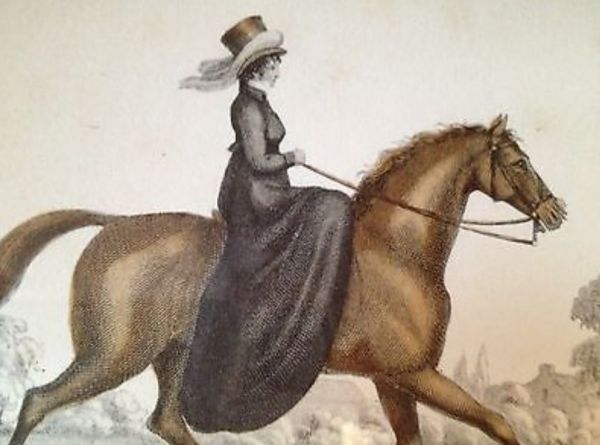
A print from about 1800. I have not been able to find paintings or other images of Celia Fiennes.
The “Woman on Horseback in a Landscape” at top of page is a 1660 painting by Gesina ter Borch. If anyone can direct me to a true likeness of Celia Fiennes please let me know.

